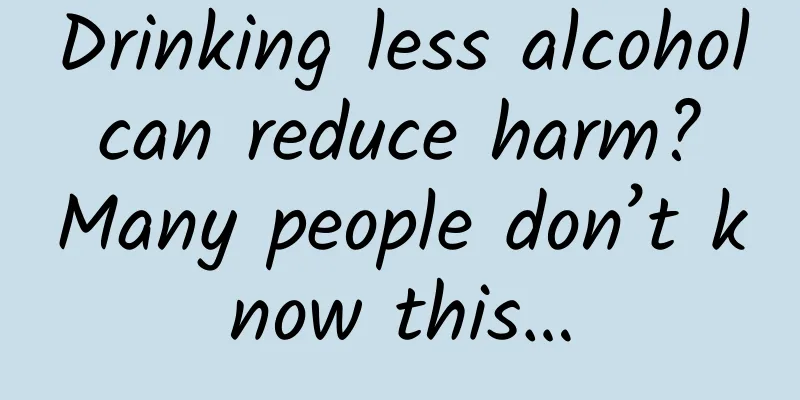Drinking less alcohol can reduce harm? Many people don’t know this…

|
Reviewer of this article: Chen Haixu, Deputy Director and Master Supervisor of the Second Medical Center of PLA General Hospital Many people have realized that drinking alcohol is harmful to health. However, many of them still have a fluke mentality, thinking that drinking a small amount of alcohol can reduce the harm. Is it really possible? Every drop of alcohol you drink is damaging your brain In March 2022, researchers from the University of Pennsylvania published a study titled "Relationship between Alcohol Consumption and Gray and White Matter Volume" in Nature Communications, a subsidiary of Nature magazine. The study found that even moderate drinking can make the brain smaller, and light to moderate drinking is associated with a reduction in overall brain volume. In this study, researchers analyzed the association between alcohol intake and brain structure in 36,678 healthy middle-aged and elderly people in the UK Biobank, using brain magnetic resonance imaging (MRI) to calculate the volume of white matter and gray matter in different areas of the brain. When the researchers divided the subjects into groups, they observed a clear trend: as alcohol intake increased, the volume of the brain's gray and white matter decreased, and the more they drank, the worse the situation became. To gain more insight into the effects of drinking on the brain, the researchers compared brain shrinkage associated with drinking with brain shrinkage associated with aging. Specifically, compared to not drinking alcohol: One unit of alcohol per day (about 8 grams of alcohol) is equivalent to half a year of brain aging; Two units of alcohol per day (about 16 grams of alcohol) will age the brain by two years; Drinking 3 units of alcohol a day (about 24 grams of alcohol) will age your brain by 3.5 years. Drinking 4 units of alcohol a day (about 32 grams of alcohol) will age the brain by more than 10 years. You should know that the common liquors on the market are usually low-proof (38%vol) and high-proof (52%vol). Now, taking the average, a bottle of 500ml 45-proof liquor contains about 225ml of pure alcohol, or about 177g. With 4 alcohol units per day, 32g of alcohol is less than 2 taels of liquor. Alcoholism is chronic suicide Drinking is not the most terrible thing about brain aging. The most terrible and most fatal harm is cerebral hemorrhage! Wan Jifeng, chief physician of the Department of Neurology at Beijing University of Chinese Medicine Dongzhimen Hospital, described a case: A man in his forties was taken to the hospital by his wife. His wife kept crying and scolding him until he was taken to the operating room. Her tone sounded like she was disappointed in him. The lady cried as she spoke, and learned that her family used to run a restaurant, and her husband had a lot of social engagements at that time, so he developed a habit of drinking. According to this lady, the restaurant business was getting worse and worse, and it was from that time that her husband became depressed and drank more and more every day. His blood pressure once dropped to 180. During this period, she argued with him, encouraged him, and persuaded him many times, but none of them helped. Until this time he collapsed and was sent to the hospital. After rescue, the man was out of danger, but unfortunately, he still suffered irreversible damage to his lower limbs, and it will be difficult for him to walk in the future. Copyright image, no permission to reprint Many alcoholics are unaware that drinking alcohol can cause cerebral hemorrhage. So why can drinking alcohol cause cerebral blood vessels to rupture and cause cerebral hemorrhage? Dr. Wan Jifeng explained that drinking alcohol can cause cerebral hemorrhage mainly due to the following reasons: First, long-term heavy drinking affects the liver first. Once the liver is affected, it promotes the synthesis of cholesterol and triglycerides, which in turn leads to arteriosclerosis. In the later stage, the lumen of the blood vessels continues to narrow, which can easily cause serious blockage of cerebral blood vessels. It can also lead to a lack of coagulation factors, reduced platelet production, and reduced response to bleeding. Second, alcohol can act on the nervous and vascular systems. When drinking, the nerves are excited. After drinking, blood pressure will continue to rise. For patients with cerebral arteriosclerosis, it is easy for blood vessels to rupture and cerebral hemorrhage to occur. Third, alcohol can stimulate the blood vessel wall, damage the endothelium, make the blood vessels lose elasticity, cause vascular hardening, and make blood vessels more prone to rupture. At the same time, alcohol can stimulate cerebral vasoconstriction, reduce blood flow, and easily cause insufficient blood supply to the brain. If a patient has three highs, cerebral arteriosclerosis, etc., drinking alcohol will directly increase the probability of cerebral hemorrhage. After cerebral hemorrhage, patients who drink alcohol for a long time have poor coagulation function, and the body does not deal well with ruptured blood vessels. In other words, the cerebral blood vessels rupture, but the body's coagulation mechanism cannot stop the bleeding at all, so the damage will be greater. The safest amount of alcohol to drink is 0! An article published in 2018 in The Lancet, the world's top medical journal, pointed out that the safest amount of alcohol consumed is zero, meaning that not drinking is best for health. Many people think that drinking too much is harmful to the body, while a small drink can cheer you up, and drinking less is good for your health. There is even a saying that "red wine softens blood vessels". In fact, these have no scientific basis at all. Not only are they not good for your health, but they are also harmful to your body in the long run. Source: Health Times The watermarked images and cover images in this article are from the copyright gallery, and the image content is not authorized for reprinting |
Recommend
Ejection seat, the skyguard of the skyguard
Some people say that the last line of defense to ...
It turns out that AI can be used in this way! Visit the AIGC Innovation Center in Turing Town and explore different artificial intelligence
【Science entry: AIGC】 This cool term is the abbre...
Are you a seventh-stage programmer?
[[130300]] Preface A programmer's programming...
How can I let the other party receive my message if I have been blocked?
With the emergence of 3G networks and the popular...
Alipay VS. WeChat are getting stronger and stronger: Who do you like more?
Mobile payments and shared bikes, China's hig...
Next-generation console competition: Chinese version of XBOX ONE and PS4 comparison
After Microsoft's XBOX ONE entered China on S...
NASA will pay you a high salary if you stay in this house for a year
On July 6, 2024, in Houston, USA, four volunteers...
A successful H5 should hit the user's key points and achieve the operation purpose
Without discussing how to define “success”, can y...
How much does it cost to create an appointment registration mini program in Huangshan?
WeChat Mini Program is an application that users ...
The mystery of blood drawing: Why is the “left ring finger” the “lucky finger for blood drawing”?
As a fast and common test method, peripheral bloo...
How much does it cost to develop the Jinhua Points Mini Program? What is the production price of Jinhua Points Mini Program?
How much does it cost to develop the Jinhua Point...
When getting the new coronavirus vaccine, why do we have to alternate between the left and right arms?
Friends who have received the new coronavirus vac...
The secret to Tik Tok user growth!
Bright Dairy, a large traditional enterprise, ord...
Why do Intel and AMD's new generation processors only support Win10?
When the Skylake Core processor was released, Mic...
Alipay has been revamped again: payment and collection are combined, and travel is included in the "Four Great Kings" for the first time
Your Alipay is about to be upgraded again! On May...









